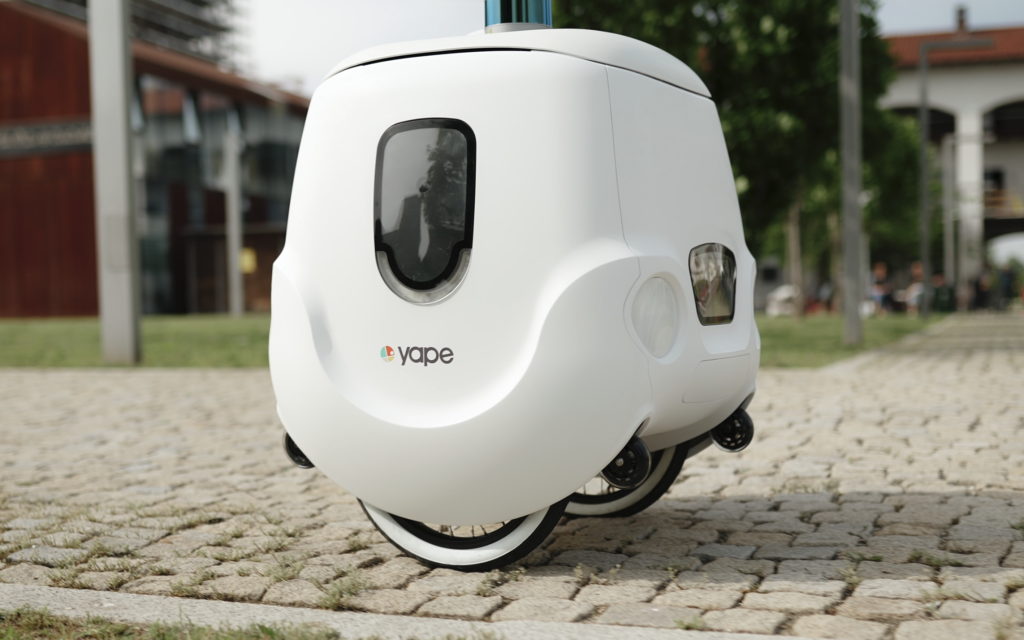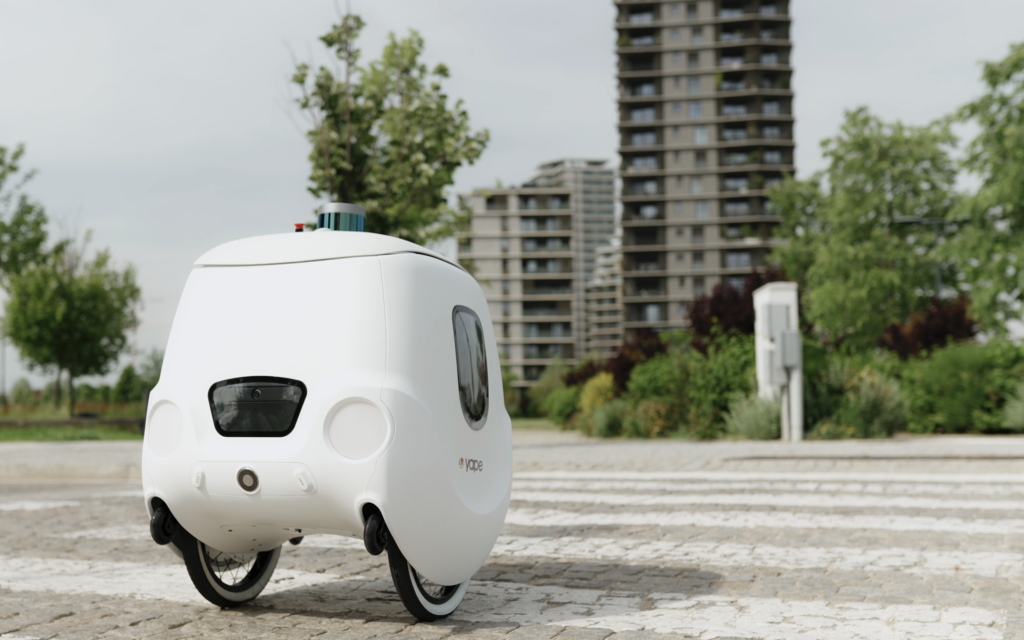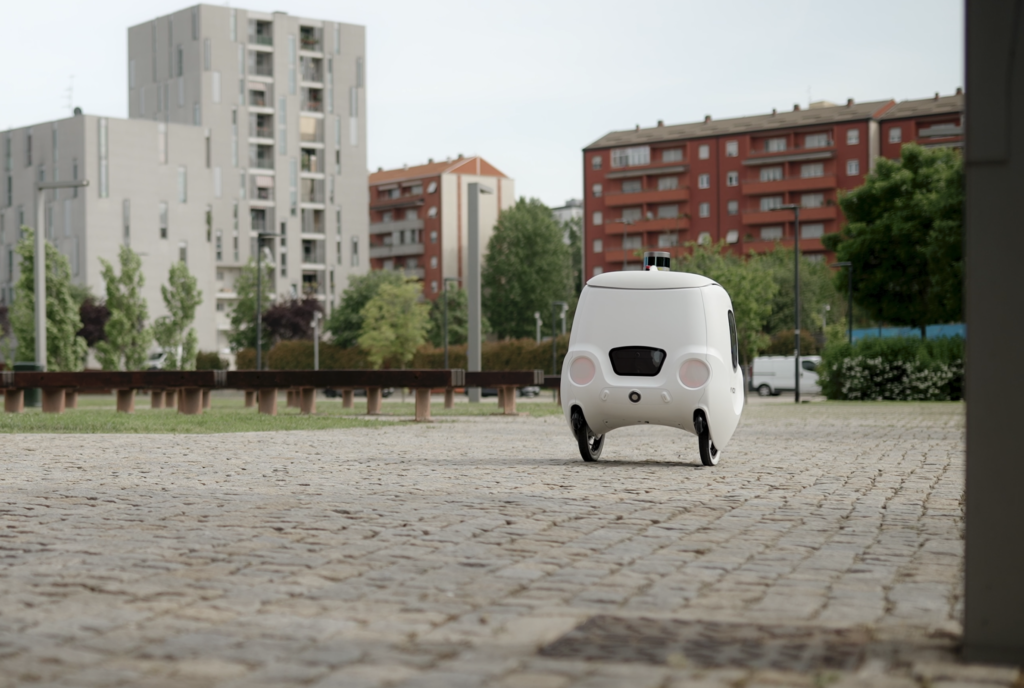Maybe you have heard of YAPE, the self-driving ground drone created for "last mile" deliveries. It is designed to transport small packages, up to 10 kg in weight, between pavements, footpaths, vehicles, rails, cobblestones and traffic lights, tackling any unforeseen obstacles the metropolitan jungle throws its way in the shortest possible time and with maximum energy efficiency, at a speed of 6 km/h. It was conceived by a team of Politecnico di Milano researchers from the MOVE research group, one of the world's leading ones in the field of autonomous driving, which developed and constructed YAPE in collaboration with the e-Novia enterprise factory (discussed in MAP #7)..
The news is that testing in an urban environment started this summer: for the next few months, 10 YAPEs will roam 'freely' (under careful supervision) across UpTown, the new high-tech residential district in Milan's Cascina Merlata area. "We are working to develop the collaborative and hyper-connected environment that characterises today's modern Smart Cities," said Vincenzo Russi, Alumnus, CEO of e-Novia and President of YAPE, "starting with the possibility of providing innovative vehicles for the transportation of goods. A project that in Italy, but also in Europe, must take into account the particular configuration of cities, which are very different from, for example, American cities. Our autonomous drone is designed to be able to move between medieval lanes and the complex topologies of Italian and European cities, enabling truly sustainable delivery".
We also discussed this with Enrico Silani, Alumnus, Chief of Entrepreneur at e-Novia and Managing Director of the newly founded YAPE S.R.Lhe is the person who has steered YAPE's development, from creating a prototype to founding the company. "We were given the go-ahead to experiment with YAPE," he explains, "thanks to the collaboration between the Department for Digital Transformation, the Ministry of Economic Development, the Ministry of Infrastructure and Sustainable Mobility, and the City of Milan, as part of Sperimentazione Italia - the Regulatory Sandbox that authorises start-ups, companies, universities and research centres to experiment on innovative projects through a temporary exemption from current regulations”.


First of all, we wanted to know who the YAPE drone is aimed at: is it designed to be sold to homeowners too? "We have not set ourselves a limit, but the diplomatic answer is no: YAPE is designed to be part of a logistics system, also for cost reasons. Generally speaking, costs in the digital electronics field follow a curve that sees significant reductions in the computing power of systems. However, in the past year this trend has changed and costs have multiplied for the same performance. So we are in a situation where it is impossible to make predictions.
The cost of raw materials, not to mention electronics, also varies from week to week. Given this situation, how can you analyse the market, calculate if a particular strategy will work or even simply provide a quote to a potential customer? “Quotations vary according to business transactions, which is now true for all vendors, from traders to service providers. The seller establishes a price according to the time that the customer is willing to wait. We operate on a case-by-case basis and, if the customer has entered into a contract with us which defines a price, we have to honour that, even if conditions change. Sometimes we find that the agreed price is below the production cost, in which case we open negotiations with the customer to see if they are willing to compromise. This is a bit like the conversations that we have with our suppliers.
. It is a very complex management engineering problem that forces us to review the hardware and software architectures of our systems, identifying the components that are more readily available than others on the market so that we can adjust as necessary. This allows us to keep the price of our product under control”.

Or, in other words, who gives it a driver’s licence? "It doesn't require a driver's licens: first of all, because it has a cylinder capacity of less than 50 cc. YAPE has not yet been officially recognised by the Highway Code, but theoretically such objects are halfway between a pedestrian, in the sense that they obey the same traffic rules as a pedestrian, and a vehicle such as an electric wheelchair (in terms of size and power). And then there is the fact that there isn’t a human driving it, but it is instead powered by artificial intelligence. A technical experimentation will gather data to better understand whether YAPE is capable of safely navigating a public area.”.
But what happens if YAPE runs a red light, for example? In this case again, the question is too human-centric: it is very difficult for an artificial intelligence to commit such a trivial offence, because it is equipped with sensors and algorithms that can handle a large number of predictable situations like this.
This is more so a question of how the drone behaves when met with different terrains and obstacles: for example, does it take the lift or the stairs?
"Let's not think about the older models of lifts we see today, which would require YAPE to have an extendible arm to push buttons placed at eye level (remember that YAPE is about half a metre tall). Instead, it is designed to interact with systems capable of exchanging messages, such as smart buildings and IoT systems, meaning it could call the lift via Bluetooth, for example.
From a technical point of view, climbing stairs and pressing buttons could certainly be possible, but it adds levels of complexity that risk compromising YAPE's cost-effectiveness. It's all a question of the cost-benefit ratio. The Cascina Merlata is a new generation of smart city district and is itself an experiment, so it is easier for YAPE to navigate”.

What happens if YAPE gets hit by a football kicked by children playing outside? Or if it comes across someone with reduced mobility? How does it first interact with pedestrians and other road users? "We have ensured that it can distinguish natural interactions with people or objects, such as cars and motorbikes, from those that are attempting to attack or vandalise YAPE. Natural interaction is one of the most studied concepts in the world; we are also undertaking a research project with the Politecnico to model pedestrian behaviour when faced with moving versus passive obstacles. The main result we are seeing is that YAPE is very positively received: it is new and therefore generates curiosity.
Then there is the question of design: YAPE has been designed to come across as friendly and empathetic. Let's go back to the elevator case. It is the same problem that we also ask ourselves about our 'fellow humans': how should I deal with those around me? Should I speak? Should I shut up? So much so that we are implementing a voice interaction system so that YAPE can give cadenced information on what it is doing”.

What happens if someone attacks him? "YAPE is equipped with a series of algorithms to detect being lifted from the ground, burglary attempts, intrusions, tampering and collisions. It is equipped with a GPS tracker and is in continuous contact with a control room, which allows operators to receive alarm signals, check its telemetry status and have access to a remote control component. But even here we are not really talking about 'hitches'.
It is, rather, a question of risk assessment, it is about the risk/benefit ratio. It is clear that we cannot protect it from every eventuality: technically everything is feasible, but building a device with the same anti-intrusion system as an ATM just to deliver a small package is not cost-effective. We haven't mentioned it, but the same applies when human beings perform operations. We see situations on a daily basis where the courier delivering our parcels leaves the van unlocked or the bicycle unattended whilst walking to our front door to get a signature, taking the risk of leaving the goods unattended for a short period of time.
When we talk about safety issues, dealing with a machine raises questions that we ignore with procedures that involve human intervention , even if they still apply. When we delegate responsibility to a computer, we instinctively ask questions that, in the case of human operators, users no longer worry about”.
Discover more: YAPE, the autonomous driving robot made in Politecnico